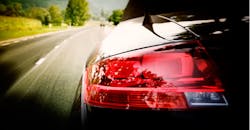2018 Audi A8 is First Production Car to Achieve Level 3 Autonomy
The phrase “Look Mom, no hands!” is generally assumed to come from the classic anecdote about boys and girls learning to ride a bike and soon finding themselves practicing riding without their hands on the handlebars. This phrase is then shouted out to call Mom’s attention to their prowess.
If this phrase is a means of showing off, then perhaps Audi engineers are entitled to shout out the equivalent phrase in German (perhaps Schauen Sie MA keine Hände?): Last week in Barcelona, the company introduced the world’s first production car offering Level 3 autonomy.
Called the “Traffic Jam Pilot.” the Audi system uses a front camera along with a combination of LiDAR, radar, and ultrasonic sensors to autonomously take control of itself and drive in highway traffic (so long as a physical barrier separates the car from traffic in the oncoming lane) at a speed of up to 37 miles per hour. A button on the A8’s center console engages the feature to start, accelerate, steer, and stop the vehicle, all without the driver paying attention.
Level 3 automation is defined as an automated driving system performing all aspects of the dynamic driving task, with the expectation that its human driver will respond appropriately to a request to intervene. It means you could use a phone once the car is in self-driving mode. Level 4 automation is similar to the Level 3, but the human driver does not need to respond appropriately to a request to intervene.
Audi claims Traffic Jam Pilot will allow drivers to completely remove their hands from the wheel and watch the car’s on-board television while the vehicle autonomously drives itself (assuming local regulations make this legal).
To achieve level 3 autonomy, the A8 employs computers from Nvidia, an image processor from Mobileye, and an array of 12 ultrasound sensors, five radars, five cameras, and one infrared camera for night vision. It also features look-ahead LiDAR—the first ever offered on a production car—supplied by Valeo.
Traffic Jam Pilot is designed to constantly monitor the driver and warn him should conditions change. It uses a series of safety checks, including:
- Driver Availability Detection to confirm that the driver is active and available to intervene. If not, it will bring the car to a safe stop. The A8 monitors the driver while Traffic Jam Pilot is engaged, and continues to do so as the speed edges up over the limit. If the driver falls asleep, it’ll wake him up.
- The vehicle ensures that the road is suitable for piloted driving by detecting features of the surroundings like lane markings, shoulders, and side barriers.
- Sensor and camera redundancy systems mean the system “sees” in multiple ways.
- Backup systems are in place for steering and braking.
Another feature on the A8, called “Remote Parking Pilot,” can direct the vehicle in and out of a parking spot or garage automatically. The driver doesn’t even need to be in the car; he or she can remotely summon or park their car by using the MyAudi smartphone app.
Audi will follow “a step-by-step approach” to introducing Traffic Jam Pilot. It plans to sell the A8 in Europe this fall for €90,600, (about U.S. $103,000), and will enter the United States market shortly after. In 2020-2021, Audi plans to introduce a Level 4 “Highway Pilot” feature that offers hands-free driving at posted limited access highway speeds in which the vehicle can execute lane changes and pass cars independently.
Audi is not alone in pursuing Level 3 autonomous capability. Cadillac’s CT6 flagship model, to be released this fall, will be equipped with a Level 3-type self-driving technology called “Super Cruise.” With a combination of cameras, sensors, and mapping data, Super Cruise will allow drivers to take their hands off the wheel during highway driving. It will not operate in the presence of stop lights, cross traffic, or pedestrians, which means it cannot be used in cities or residential communities.
Super Cruise utilizes a driver attention system and precision LiDAR map data (claimed to be accurate to within five centimeters) to ensure safe vehicle operation. Engineers mapped every mile of limited-access highway in the U.S. and Canada to provide detailed information to the car about the road ahead. The system is said to be able to measure real-time location four to eight times more precisely than traditional GPS.
A driver-facing camera attached to the top of the steering column uses infrared light to track head position and which direction the driver is facing, as well as to determine whether the driver is paying attention. If the driver’s attention wanders, Super Cruise engages a series of alerts. For example, a light bar will start flashing red, audible chimes or beeping will begin, and Cadillac’s Safety Alert Seat will vibrate. If these warnings are ignored, the car will pull over and come to a safe stop.
Perhaps in response to advances being made by its competitors, Hyundai Motor Company is planning to introduce its “HDA2 (Highway Driving Assist 2),” which has semi-self-driving functions, one year earlier than planned. HDA2 will enter a junction and go onto a main road on its own if a driver turns it on while he or she is driving on a freeway. HDA2 also automatically controls speed when a car suddenly cuts in front of it. While Hyundai’s current HAD can only detect objects in the front and the back of a car, HDA2 can detect every area due to an increased number of sensors.
The HDA3 system sought by Hyundai for 2020 will allow lane changes and other autonomous driving functions to work without intervention by the driver, according to the company. Hyundai expects to commercialize complete self-driving cars by 2022.


